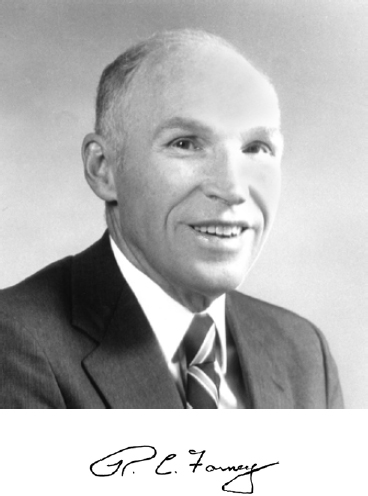He was repeatedly honored, starting early in his career with the Lawrence Sperry Award (1949) from the Institute of Aeronautical Sciences (now the American Institute of Aeronautics and Astronautics, AIAA); distinguished service medals from the Air Force (1961, 1969), NASA (1968), DIA (1974), and Department of Defense (1983); the General Thomas D. White US Air Force Space Trophy (1966); the von Kármán Medal (1978) from the Advisory Group for Aerospace Research and Development (AGARD-NATO); and the Clifford Furnas Award (1986) from SUNY Buffalo. He was a Wright Brothers Lecturer for AIAA and a Wilbur and Orville Wright Memorial Lecturer for the British Royal Aeronautical Society.
He was selected to receive the 2007 Guggenheim Medal of the American Society of Mechanical Engineers (ASME), AIAA, American Helicopter Society (AHS), and Society of Automotive Engineers (SAE) “for outstanding contributions to aerospace engineering in aeroelasticity, unsteady aerodynamics, and flight mechanics, and for exceptional leadership of engineering organizations including service to the US Department of Defense.”
In addition to his NAE membership, he was an honorary fellow of AIAA, was named Elder Statesman of Aviation by the National Aeronautic Association, and was inducted into the Niagara Frontier Aviation Hall of Fame.
Dr. Flax was a genius at repairing old hardware. He also enjoyed a “hobby” of writing out long differential and integral equations on any paper available, including the margins in the TV Guide and scraps of cardboard.
He was preceded in death by his wife of 60 years, Ida Leane Warren Flax, an Army cryptanalyst during World War II and a mathematician who worked on pioneering aircraft at the Piasecki Helicopter Company in the 1940s. She died in 2011. They are survived by their daughter Laurel Flax and many nieces and nephews.
Al is warmly remembered by his colleagues and the many who benefited from his wise advice and counsel. He was truly one of the giants of the aerospace and defense world.

ROBERT C. FORNEY
1927–2016
Elected in 1989
“For leadership of chemical engineering research, innovative process developments, and creative technology management.”
ROBERT CLYDE FORNEY died August 3, 2016, at the age of 89. He was born March 13, 1927, in Chicago, to Peter Clyde and Hildur Hogland Forney.
If ever there was a role model for how a life should be led, Bob Forney illustrates one to near perfection. Possessed of enormous technical and managerial talent, which he applied throughout his career at E.I. du Pont de Nemours & Company, he shared those talents with many outside organizations and people. It is a pleasure to enumerate the many ways this vigorous, principled, and brilliant man gave back to others during his life.
He was an outstanding student at Purdue University (1944–50), where he received a BS and PhD in chemical engineering and an MS in industrial engineering. In 1948 he married his classmate Marilyn Glenn.
Immediately after graduation he joined the DuPont Company as an engineer. His ability to get things done right was soon recognized and he was put on the management fast track. To anyone who knew Bob it was quickly apparent that this was a man of amazing analytical abilities. And he was not
___________________
1 I appreciate valuable comments and suggestions from Marilyn Forney, Bob’s widow, who allowed me to visit her to discuss this tribute.
only driven by facts and figures, he was also kind. This was evident in his work as he oversaw some of the most important advances in industrial polymer and synthetic fiber manufacture, while he took care in teaching and professionally developing those who reported to him.
He moved rapidly through assignments at DuPont, including the development of many new polymeric resins, most notably Dacron polyester fiber. Following this and other achievements he was selected to head one of DuPont’s major businesses, the Textile Fibers Department. He went on to become a member of the company’s executive committee, which managed all the major capital investments and business strategies.
Bob’s reputation extended beyond DuPont. He was elected to the NAE in 1989 and served on 19 studies and panels as either chair or contributing member. For example, he was a member of the National Research Council Panel on Technical Evaluation of NASA’s Proposed Redesign of the Space Shuttle Solid Rocket Booster, which led to greatly improved safety of all subsequent space shuttle missions. For this service he received the prestigious NASA Public Service Award as well as the highly coveted “Silver Snoopy” award.
He was also a trustee for the Philadelphia Academy of Natural Sciences, and chair of the board for the Chemical Manufacturers Association (1988–89) and Advisory Board of the National Science Resources Center (a joint venture of the Smithsonian Institution and National Research Council; 1987–90), to mention just a few. As was always the case, when Bob agreed to participate in anything, he did so with effectiveness and enthusiasm.
As someone who worked directly under Bob for several years I can bear witness to his brilliance as an administrator and as a developer of people. He was known as a great guy to work for because of his demanding standards tempered by great humanity.
Bob never forgot the debt he owed to Purdue. He was a member of the Purdue Research Foundation for two decades and cochaired the Class of 1947 Scholarship Fund. The




